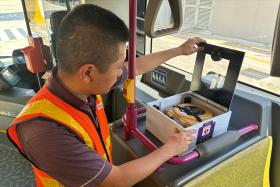Factoring in operating costs may raise public transport fares: Experts
Public Transport Council says operational costs, network usage will be considered in new fare formula
The Public Transport Council (PTC) announced yesterday that public transport fares will now take operational costs and network usage into account.
This might cause public transport fares in general to increase in the future, transport experts told The New Paper.
PTC announced the results of its fare formula review yesterday. The current formula factors in issues such as the cost of living and the prices of electricity and diesel. It also includes sharing half of the public transport operators' productivity gains with commuters.
With the new fare formula, an additional component called the Network Capacity Factor will calculate capacity provision in relation to passenger demand.
It measures the change in the capacity and distance travelled by trains and buses in relation to the distance travelled by commuters in the preceding year.
PTC chairman Richard Magnus said in a statement to the media: "To remain relevant, our fares, including the transfer rules, have to be adjusted to the market dynamics as well as commuter needs.
"This is critical in ensuring the long-term financial sustainability, ease and seamlessness of our public transport network."
He added that he is unable to say if fares will increase this year, since PTC is still calculating the fares according to the revised formula.
However, a 3.2 per cent fare reduction, rolled over from last year's fare review, could help offset any increase resulting from the new component, he said.
Dr Park Byung Joon from the Singapore University of Social Sciences told TNP: "I expect the fares to go up. Now we have more rail networks and it is not free. Someone has to pay... In terms of business sustainability, it is a good move."
The PTC said that fares have not kept pace with the higher operating costs arising from capacity expansion and the widening gap between cost and fares is unsustainable.
Between 2012 and 2016, annual operating costs increased by over $900 million. However, annual fare revenue increased by only $230 million over the same period.
SENSIBLE
Transport Minister Khaw Boon Wan said in a Facebook post that the new component is "sensible".
He said: "As the network expands or intensifies in response to changing commuter demand, it impacts the financial sustainability of the transport system.
"When changes are significant, some adjustments to fares, whether upwards or downwards, will ensure fairness between taxpayers and commuters."
From 2012 to last year, public transport capacity increased by around 25 per cent. About 1,000 new buses and 200 new trains were injected into the network.
The rail network also increased by 74km, spanning a total of 230km across five MRT lines and two LRT systems.
Transport economist Walter Theseira added that fares will likely go up gradually, even if they do not increase right away.
He said: "This new component provides a clear link between service quality and what commuters have to pay.
"Ridership growth has been quite stagnant in recent years but capacity has increased. So, this component will have a positive number. Ultimately, fares will have to go up in the future or the system will be unsustainable."
PTC said the 2018 fare adjustment will be finalised and announced towards the end of the year.
Cheaper fares, more flexibility under new transfer rules
Commuters will be able to plan journeys with more flexibility, with the new distance fare transfer rules.
Under the new rules, commuters who tap out of a station and enter another station will not have to pay their boarding fare twice.
The rules will come into effect together with the annual fare adjustments, which will be announced later this year.
The Public Transport Council (PTC) announced that with more rail lines opening, there will be more instances where commuters might want to save time by using a combination of rail rides to reach their destination. These could include walking from one station to another one nearby.
Currently, commuters who make such transfers will have to pay another 77 cents when they enter a new station.
With the new rules, commuters will be able to make transfers between any two different MRT or LRT stations within 15 minutes without incurring extra charges.
Commuters can also change from trains to buses to trains again without incurring extra charges.
As long as the entire process is within two hours, it will be considered a single journey.
For example, if a commuter takes the Downtown Line from Little India to Bendemeer, which takes about 20 minutes, he has to pay $1.16.
However, the commuter may choose to skip the Downtown Line loop by exiting at Rochor station and walking to Jalan Besar station, before continuing his journey to Bendemeer.
This option will take him about 15 minutes and cost $1.54 under the current rules.
With the updated rules, it will cost only 77 cents.
PTC said it expects at least 6,000 daily journeys to have shorter travel times and lower fares.
18 PAIRS
There are around 18 pairs of MRT stations that are within a 15-minute walk from each other. Commuters who choose to walk between these stations can benefit from the new rules.
PTC said: "We expect even more commuters to benefit eventually as they adjust their current travel routes to take advantage of the new transfer rules."
Mr Sitoh Yih Pin, chairman of the Government Parliamentary Committee for Transport, added: "For commuters, the removal of the additional boarding charges means more flexibility to enjoy the greater connectivity of the public transport network, for a more seamless travel in their day-to-day lives."
Get The New Paper on your phone with the free TNP app. Download from the Apple App Store or Google Play Store now


